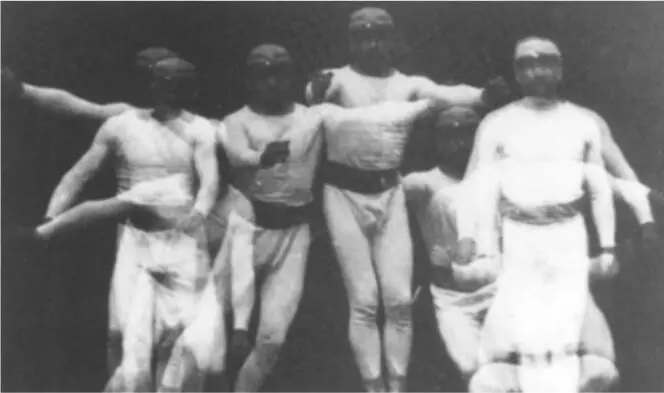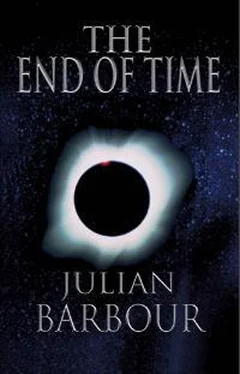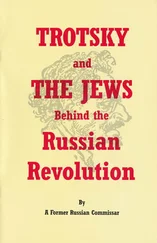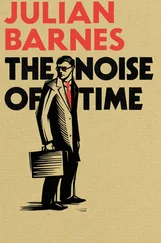I suggest that the brain in any instant always contains, as it were, several stills of a movie. They correspond to different positions of objects we think we see moving. The idea is that it is this collection of ‘stills’, all present in any one instant, that stands in psychophysical parallel with the motion we actually see. The brain ‘plays the movie for us’, rather as an orchestra plays the notes on the score. I am not going to attempt to elaborate on how this might be done; all I want to do is get the basic idea across. There are two parts to it. First, each instantaneous brain pattern contains information about several successive positions of the objects we see moving in the world. These successive positions need correspond only to a smallish fraction of a second. Second, the appearance of motion is created by the instantaneous brain pattern out of the simultaneous presence of several different ‘images’ of the gymnasts contained within it (Figure 2). This happens independently of the earlier and later brain states.

Figure 2.My explanation of how it might be possible to ‘see’ motion when none is there is illustrated in this chronophotograph of a sideways jump. My assumption is that the pattern of the atoms in our brain encodes, at any instant, about six or seven images of the gymnast. The standard ‘temporal’ explanation is that the gymnast passes through all these positions in a fraction of a second. My idea is that when we think we are seeing actual motion, the brain is interpreting all the simultaneously encoded images and, so to speak, playing them as a movie.
This proposal is not so very different from Boltzmann’s idea that the sense of motion is created from several qualitatively different patterns arranged along the ‘line of time’. Instead, I am suggesting that it is created by the brain from the juxtaposition of several subpatterns within one pattern. The arrow of time is not in the washing line, it is not in several pieces of washing, it is in each piece. If we could preserve one of these brain patterns in aspic, it would be perpetually conscious of seeing the gymnasts in motion. If you find this idea a bit startling, I am glad because I find it does bring home the ‘freezing of motion’ that I think we have to contemplate. In fact, since brain function and consciousness are fields in which I have no expertise, I would like you to regard this suggestion in the first place as a means of getting across an idea, the main application of which I see in physics.
To that end, I want to introduce the notion of special Nows, or time capsules , as I call them.
TIME CAPSULES
By a time capsule, I mean any fixed pattern that creates or encodes the appearance of motion, change or history. It is easiest to explain the idea by examples, for example the Ariel in the storm in Turner’s painting. Although they are all static in themselves, pictures often suggest that something has happened or is happening – with a vengeance in this painting. But in reality it simply is. I know no better example of something static that gives the impression of motion.
In pictures, the impression is deliberately created. Much more significant for my purposes are time capsules that arise naturally and have to be interpreted, by the examination of records they seem to contain. Records, or apparent records, play a vital role in my idea that time is an illusion. I use records primarily in the sense of, for example, fossils, which occur naturally and are interpreted by us as relics of things that actually existed. Less directly, all geological formations, rock strata in particular, are now invariably interpreted by geologists as constituting a record (to be interpreted) of past geological processes. Finally, there are records that people create deliberately: doctors’ notes, minutes of committee meetings, astronomical observations, photographs, descriptions of the initial and final conditions of controlled experiments, and so on. All such things, and many more, I call records. My position is that the things we call records are real enough, and so is their structure. They are the genuine cause of our belief in time. Our only mistake is the interpretation: time capsules have a cause, but time is no part of it.
Let me now attempt a more formal definition. Any static configuration that appears to contain mutually consistent records of processes that took place in a past in accordance with certain laws may be called a time capsule. From my point of view, it is unfortunate that the dictionary definition (in Webster’s ) of a time capsule is ‘a container holding historical records or objects representative of current culture that is deposited (as in a cornerstone) for preservation until discovery by some future age’. I do not mean that. But we have all had the experience of walking into a house untouched by historical development for decades or centuries and declaring it to be a perfect time capsule. This, I believe, happens to us in each instant of time we experience. The only difference is that we experience our current time capsule, not someone else’s. And we are mistaken in the way we interpret the experience.
It is important for me that, as I point out in the next section, the phenomenon of time capsules is very widespread in the physical world, and is not restricted to our mental states and experiences. In addition to my caveat at the end of the previous section, I should emphasize that I am not claiming consciousness plays some remarkable novel or extraphysical role in the world. Unlike Roger Penrose in his best-seller The Emperor’s New Mind , I am not suggesting that there is any ‘new physics’ associated with mental states. There may be, but that is not part of my time-capsule idea. However, I do believe we have to think carefully about the role of consciousness in the picture that we form of the world.
First, all knowledge and theorizing comes to us through the conscious state. If we want to form an overall picture of things, we cannot avoid allotting a place to consciousness. It is necessary for completeness: we have to consider ‘where we stand’. This is closely related to a second factor. Viewed as a physical system, the brain is organized to an extraordinary degree. It is vastly more complicated and intricate than the air we breathe or the star clusters we see through telescopes. There may not be any locations anywhere in the universe that are more subtly and delicately organized than human brains. There is not merely the brain structure as such, but also the distillation of accumulated human experience and culture that we carry in our brains. But this very organization may be giving us a distorted picture of the world. If you stand, like Turner bound to the Ariel’s mast, in the tornado’s maelstrom, you might well suspect that the universe is just one great whirlpool.
The lesson we learned from Copernicus, Kepler and Galileo is here very relevant. They persuaded us, against what seemed to be overwhelming evidence to the contrary, that the Earth moves. They taught us to see motion where none appears. The notion of time capsules may help us to reverse that process – to see perfect stillness as the reality behind the turbulence we experience.
Stand, as 1 have with a daughter, and look at Jupiter against the winter stars. Every clear frosty night we stood on the utterly motionless Earth – as it appeared to our senses – and watched through the winter as Jupiter, high in the sky, tracked night by night eastwards against the background of the stars. But then Jupiter slowed down, came to a stop, and went backwards in the retrograde motion that so puzzled the ancients. Then this motion stopped, and the eastwards motion recommenced. In all this Jupiter moved, not us. We could see it with our eyes. Seeing is believing. But what did Copernicus say? We must be careful not to attribute to the heavens (Jupiter) what is truly in the Earth-bound observer. I could persuade my daughter that the motion of the Earth, not of Jupiter, gives rise to the retrograde motion. To interpret events, we must know where we stand and understand how that affects what we witness. But we observe the universe from the middle of a most intricate processing device, the human brain. How does that affect our interpretation of what we see?
Читать дальше













